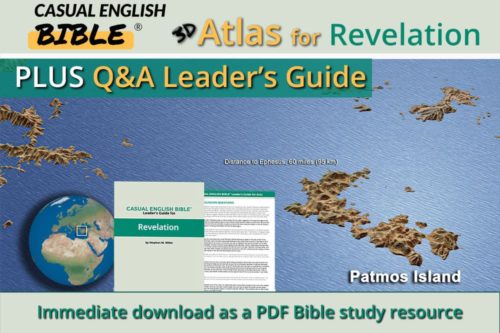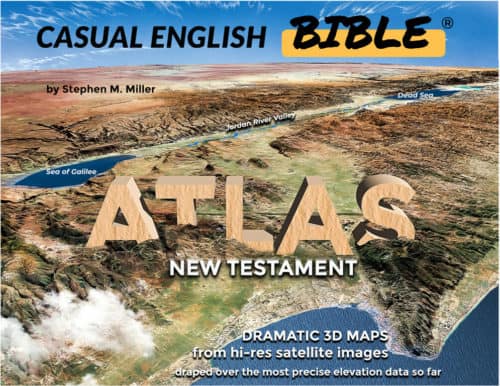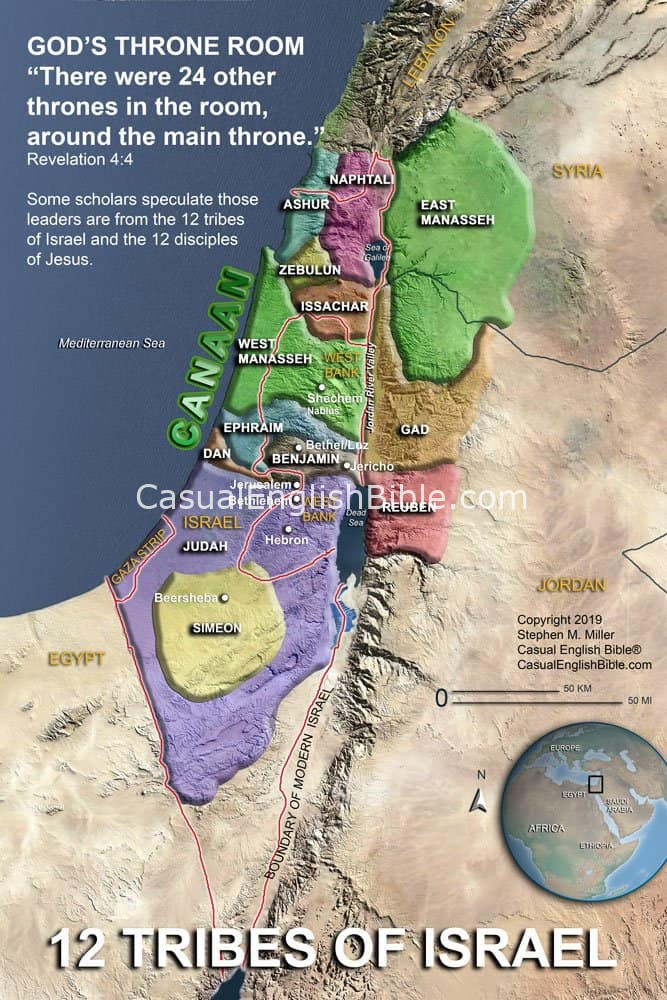Revelation 4
A visit to heaven
John Steps into Heaven
1Then I saw a doorway into heaven. The door stood wide open. I heard a voice [1] inside heaven calling me. It was the same voice that had spoken to me earlier. This time the voice sounded like a trumpet’s announcement. It said, “Come on up here. I’ll show you what’s going to happen next.” 2Suddenly, I found myself inside heaven’s throne room, with someone sitting on the throne. I wasn’t there physically, but in spirit. 3The one sitting on the throne looked glorious, like gems of jasper and carnelian. An emerald glow hovered above and around the throne, like a rainbow. [2] 4There were 24 other thrones in the room, around the main throne. Leaders [3] wearing white clothes and gold crowns sat on those.Kind Words Fill Heaven’s Throne Room
5Lightning flashed from the throne, as thunder rumbled. Seven torches burned in front of the throne. These were the seven spirits of God. [4] 6In front of the throne I saw something that looked like a crystal sea. [5] It seemed made of glass instead of water. Four living beings stood near the throne. They were covered in eyes, front and back. [6] 7Each of the four beings looked like a different creature: lion, ox, flying eagle, and one that had a face resembling a man. [7] 8Each of these four beings had six wings [8] and were covered with eyes. Day and night, without a break, they chanted these words:“Holy, holy, holy, Lord God Almighty,
who was, is, and will always be.” [9]
11“Lord, our God, [10]
you deserve glory, honor, and power.
You created everything.
Everything in creation exists
because you wanted it and made it.” [11]
Footnotes
This is possibly the voice of the angel from Revelation 1:10 instead of Jesus from 1:17.
John seems to be describing the regal glory of God’s throne. Some scholars link John’s words to the prophecy of Ezekiel, which describes the “Son of man” as wearing similar regal clothes, studded with gems including red carnelian, jasper, and emerald (Ezekiel 28:13).
Literally “elders,” who weren’t necessarily older adults, but who held positions of authority in ancient Israel. Scholars can only guess who these people were. Among the many guesses: (1) Representatives of Israel and the church, with 12 from the dozen tribes of Israel and 12 of Jesus’s disciples. (2) Leaders of the 24 divisions of Israel’s musicians (1 Chronicles 25). (3) Christian martyrs. (4) Jewish leaders from Old Testament times.
See Revelation 3:1, which says the seven spirits may have been angels. Some Jewish writers in ancient times seemed to say angels were made of fire. Bible writers often describe angels as glowing. The angel that rolled aside the stone blocking the entrance into the tomb of Jesus “glowed like a burst of lightning. His clothes were snow white” (Matthew 28:3).
Ezekiel 1:22 reports a vision of God’s glory, with a sky gleaming like crystal.
Some scholars identify the four beings as cherubim who the prophet Ezekiel said carried God’s throne out of the Jerusalem Temple before the city fell to Babylonian invaders in 586 BC (Ezekiel 10:18-20). They had four faces, with eyes looking in all four directions. Some say the idea of creatures like this positioned near a throne sounds like the winged lions and sphinxes of the Assyrians, Babylonians, and Egyptians. The images in John’s vision may have made more sense to him because he was familiar with these earlier and similar images.
In Ezekiel’s vision, each of the four beings had four faces: lion, bull, eagle, and human (Ezekiel 1:10).
Six wings are an upgrade from the four-winged beings Ezekiel reported (Ezekiel 1:8). But the descriptions match that of the six-winged beings called seraphim in Isaiah’s vision (Isaiah 6:2).
The lyrics of this chant are similar to the chant Isaiah heard during a vision when the Jewish people faced the threat of invaders: “Holy, Holy, Holy, is the LORD of hosts [heaven’s army], / The whole earth is full of His glory” (Isaiah 6:3, New American Standard Bible). We might think one “holy” is enough to get the point across that the Lord is one of a kind and compassionate and devoted to those he loves—and everything good that’s wrapped up in the word “holy.” But standing in the presence of the Lord in a place as glorious as heaven apparently warrants repeating the word a couple of times. John certainly writes as though he’s wowed by what he sees in this vision.
If John wrote Revelation in the AD 90s, as many speculate, these lyrics would have offended the reigning emperor, Domitian (ruled AD 81-96). A Roman historian named Suetonius (about AD 69-126) said Domitian ordered his governors known as procurators to sign their official letters in his name. Instead of writing “Sincerely yours,” they would have written in Latin that they were sending their letter in the name of “dominus et deus noster,” our lord and god. John, in Revelation, was reporting a vision that seemed to suggest Domitian had an inflated view of himself. The genuine Lord and God of John’s vision is the one whom Romans crucified but who is now sitting on a throne as an immortal deity.
This is an example of Hebrew poetry. English poetry often rhymes. But Hebrew poetry repeats ideas instead of sounds. One line might make a statement and the second line would repeat the idea. That’s what’s happening in the two closing lines in this four-line verse. The last line repeats the idea of the line before it.
Discussion Questions
- 1
In John’s vision of God’s throne room in heaven, he sees 24 thrones around the main throne. He reports seeing what many Bible translators call “elders” or “leaders” (Revelation 4:4) sitting on those thrones, wearing white clothes and gold crowns. Scholars can do little more than guess about who those 24 leaders are. Of the following educated guesses, which sounds most reasonable to you?
- 12 from the dozen tribes of Israel and 12 of Jesus’s disciples
- Leaders from Israel’s 24 divisions of musicians
- Christian martyrs
- Jewish leaders from Old Testament times
- 2
John describes the looks of some frightening beings in heaven. Four of them located near the throne of God “were covered in eyes, front and back” (Revelation 4:6). Each one looked like a different creature: “lion, ox, flying eagle, and one that had a face resembling a man” (Revelation 4:7). And they had “six wings . . . covered with eyes” (Revelation 4:8). Some scholars say the eyes represent the fact that God is able to see all things and that he has heavenly beings assigned to this. Early church leaders said they represented the four evangelists they believed wrote the four Gospels about Jesus: Matthew, Mark, Luke, and John. But they couldn’t agree on which creature represented which evangelist. Do you think what John is describing represents what actually exists in heaven or is this symbolic of something else going on?
- 3
Okay, no offense to God Almighty, but it can seem a bit insecure of God to have four celestial beings chanting the following words “day and night, without a break”: “Holy, holy, holy, Lord God Almighty, who was, is, and will always be” (Revelation 4:8). How would you explain that to someone outside the faith who said that sounds like something a dictator or a king might do if he was suffering from daddy issues or other problems that had eroded his sense of self-esteem?
- 4
LIFE APPLICATION. John reports seeing the 24 leaders who sit on thrones in God’s throne room bow to God. “They put their crowns in front of his throne and together say: ‘Lord, our God, You deserve glory, honor, and power. You created everything. Everything in creation exists because you wanted it and made it’” (Revelation 4:11). If you got a chance to stand before God today, and you felt compelled to thank him for something, what would it be?







